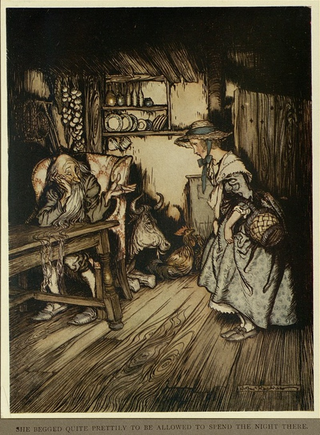Related Research Articles
The Aarne–Thompson–Uther Index is a catalogue of folktale types used in folklore studies. The ATU Index is the product of a series of revisions and expansions by an international group of scholars: originally composed in German by Finnish folklorist Antti Aarne (1910), the index was translated into English, revised, and expanded by American folklorist Stith Thompson, and later further revised and expanded by German folklorist Hans-Jörg Uther (2004). The ATU Index, along with Thompson's Motif-Index of Folk-Literature (1932)—with which it is used in tandem—is an essential tool for folklorists.

"Maid Maleen" is a German fairy tale collected by the Brothers Grimm, number 198.

"The Wolf and the Seven Young Goats" is a fairy tale collected by the Brothers Grimm and published in Grimm's Fairy Tales. It is of Aarne-Thompson type 123 "The Wolf and the Kids".

"The Hut in the Forest" is a German fairy tale collected by the Brothers Grimm. Andrew Lang included it in The Pink Fairy Book (1897). It is Aarne-Thompson type 431.

The Lute Player, The Tsaritsa Harpist or The Tsaritsa who Played the Gusli, is a Russian fairy tale. It was published by Alexander Afanasyev in his collection Russian Fairy Tales, as number 338. Andrew Lang included it in The Violet Fairy Book (1901).
Boots and His Brothers is a Norwegian fairy tale collected by Peter Christen Asbjørnsen and Jørgen Moe in their Norske Folkeeventyr.

The King of England and his Three Sons is a Romani fairy tale collected by Joseph Jacobs in More English Fairy Tales. He listed as his source Francis Hindes Groome's In Gypsy Tents, where the informant was John Roberts, a Welsh Roma. Groome published the tale as An Old King and his three Sons in England.

The Magic Swan Geese is a Russian fairy tale collected by Alexander Afanasyev in Narodnye russkie skazki, numbered 113.
The Well of the World's End is an Anglo-Scottish Border fairy tale, recorded in the Scottish Lowlands, collected by Joseph Jacobs in English Fairy Tales. His source was The Complaynt of Scotland, and he notes the tale's similarity to the German Frog Prince. Like that tale, it is Aarne-Thompson type 440, "The Frog King" or "Iron Henry".
Biancabella and the Snake is an Italian literary fairy tale written by Giovanni Francesco Straparola in The Facetious Nights of Straparola.

Grateful dead is both a motif and a group of related folktales present in many cultures throughout the world.

"The Gnome" is a German fairy tale collected by the Brothers Grimm in Grimm's Fairy Tales, tale number 91.
How the Daughter-in-Law Got the Coins is a Sri Lankan fairy tale collected by H. Parker in Village Folk-Tales of Ceylon.
"The Three Snake-Leaves" is a German fairy tale collected by the Brothers Grimm, tale number 16. It is Aarne-Thompson type 612, "The Three Snake-Leaves".
The Crow is a Slavic fairy tale of Polish origin, translated by Hermann Kletke as Die Krähe, in his folktale compilation Märchensaal aller Völker. Andrew Lang included it in The Yellow Fairy Book.
Verlioka or wyrlook is an East Slavic fairy tale collected by Alexander Afanasyev in Narodnye russkie skazki (1855–63). It is classified in the Aarne-Thompson-Uther Index as tale type ATU 210*, "Verlioka".
The Calumniated Wife is a motif in traditional narratives, numbered K2110.1 in Stith Thompson's Motif-Index of Folk-Literature. It entails a wife being falsely accused of, and often punished for, some crime or sin. This motif is at the centre of a number of traditional plots, being associated with tale-types 705–712 in the Aarne–Thompson–Uther Index of tale-types.
In folkloristics, "The Animal as Bridegroom" refers to a group of folk and fairy tales about a human woman marrying or being betrothed to an animal. The animal is revealed to be a human prince in disguise or under a curse. Most of these tales are grouped in the international system of Aarne-Thompson-Uther Index under type ATU 425, "The Search for the Lost Husband". Some subtypes exist in the international classification as independent stories, but they sometimes don't adhere to a fixed typing.
The Golden Eggplant is a Japanese folktale, published by scholar Seki Keigo in Folktales of Japan. Scholars relate it to tale type ATU 707, "The Three Golden Children", of the international Aarne-Thompson-Uther Index.

The Dog in the Sea, also known as The Dog and the Sailor is a northern European fairy tale classified as ATU 540, "The Dog in the Sea".
References
- ↑ D. L. Ashliman, "Killing of Old Men: folktales of Aarne-Thompson type 981 and other legends about geronticide"
- ↑ Uther, Hans-Jorg (2004). The Types of International Folktales: A Classification and Bibliography. Helsinki: Suomalainen Tiedeakatemia Academia Scientiarum Fennica. p. 612.
- ↑ D. L. Ashliman, Why old people are no longer put to death
- ↑ Uther, Hans-Jorg (2004). The Types of International Folktales: A Classification and Bibliography. Helsinki: Suomalainen Tiedeakatemia Academia Scientiarum Fennica. p. 612.
- ↑ Murray, Margaret; Galea, L. (1932). Maltese Folk-Tales. Empire Press.
- ↑ Coxwell, Fillingham (1925). Siberian and Other Folk-Tales. London: C. W. Daniel Company. p. 418. Retrieved 13 August 2024.
- ↑ Dorson, Richard (1972). African Folklore. New York: Anchor Books. pp. 403–404.
- ↑ Bundy, Richard (1919). "Folk-Tales from Liberia (In Abstract)". Journal of American Folk-Lore. 32 (125): 415. Retrieved 21 March 2024.
- ↑ Seki, Keigo (1963). Folktales of Japan. University of Chicago Press. pp. 183–186.